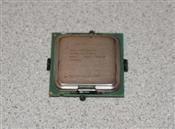Intel Pentium 4 6XX Sequence and 3.73GHz Extreme Edition Processors
Introduction and Specfications
 It's no secret that Intel has occassionally been playing a bit of catchup this year in the desktop and workstation processor arena. AMD's Athlon 64 releases have recently positioned the company in the lead from a general performance standpoint. Additionally, the Athlon 64 was the first processor to market with 64-bit extensions and processing capabilities, although there really hasn't been much if any impact in consumer or business usage models for the new architecture because there are scarce few 64-bit applications available, much less a mainstream 64-bit OS. Of course that's something Intel will be quick to point out as an "I told you so," but you've got to hand it to AMD for blazing a trail. You could easily argue that Intel has been blazing a trail of its own for a while now in multithreaded computing with the release of the Pentium 4 architecture's Hyper-Threading technology, which will evolve once again later this year as multicore CPUs are brought to market by both camps.
It's no secret that Intel has occassionally been playing a bit of catchup this year in the desktop and workstation processor arena. AMD's Athlon 64 releases have recently positioned the company in the lead from a general performance standpoint. Additionally, the Athlon 64 was the first processor to market with 64-bit extensions and processing capabilities, although there really hasn't been much if any impact in consumer or business usage models for the new architecture because there are scarce few 64-bit applications available, much less a mainstream 64-bit OS. Of course that's something Intel will be quick to point out as an "I told you so," but you've got to hand it to AMD for blazing a trail. You could easily argue that Intel has been blazing a trail of its own for a while now in multithreaded computing with the release of the Pentium 4 architecture's Hyper-Threading technology, which will evolve once again later this year as multicore CPUs are brought to market by both camps.
Regardless, while AMD seemingly has been riding relatively high over the past 12 months, from a mindshare standpoint, Intel has been rather quietly advancing the Pentium 4 architecture such that today, the company many refer to as "Chipzilla" is bringing to bear significant innovations as well as a solid beefing-up of its current mainstream and enthusiast CPUs. Today marks the debut of an entire new lineup of processors from Intel with the company's 6XX Sequence Pentium 4, as well as a new addition to the Pentium 4 Extreme Edition family. These new Pentium 4 cores offer both architectural enhancements and new features including new Intel innovations such as EM64T extensions for 64-bit computing, "SpeedStep" power-savings technology, and new security improvements with Intel's "Execute Disable Bit" feature.
Here's a run down of what's under the hood of these new P4s, as well as what is in store for you in the pages ahead as we run these new chips through their paces.
|
|
Both of these new processors are based on what is known as Intel's Prescott 2M core for the Pentium 4. They have very deep 31-stage pipelines, which means they can hit impressively high clock speeds but somewhat at the expense of longer latencies on branch execution misses because the core must reissue back through that long pipeline. In addition, both of these CPUs have the beefed-up 2MB L2 caches on board, which should assist significantly in keeping that pipeline full with data from this local on-chip high-speed memory rather than going off chip to significantly slower system memory.
As noted earlier, there are also a few new features that these Prescott 2M cores bring to market for the P4, namely Intel EM64T 64-bit extensions, EIST or Enhanced Intel SpeedStep Technology (6XX sequence CPUs only at the moment), and the Execute Disable Bit, all of which we'll dig into next.










